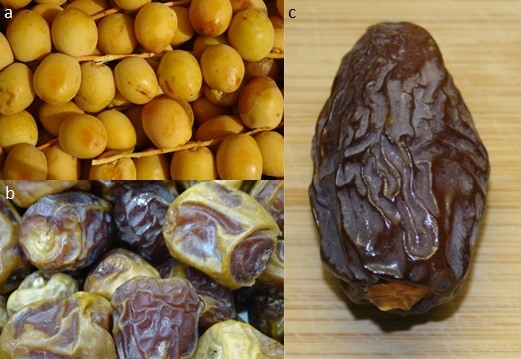Department of Agriculture and Water Resources, August 2016
Download
| Document | Pages | File type | File size |
|---|---|---|---|
| Biosecurity Fact Sheet: Fresh date fruit from the Middle East and North Africa region | 2 | 540 KB |
If you have difficulty accessing these files, visit web accessibility for assistance.
Online version
Key points
- The Department of Agriculture and Water Resources is conducting a review of biosecurity import requirements (non-regulated risk analysis) for fresh date fruit (greater than 30 per cent moisture content) from the Middle East and North Africa region.
- A draft report is scheduled to be published around February 2017, following which stakeholders can lodge submissions during a 60 calendar day consultation period.
- The final report is expected to be published by 30 June 2017.
Rationale for the review
A review of biosecurity import requirements for fresh date fruit (fresh dates) has commenced in response to requests for market access for fresh dates (with more than 30 per cent moisture content) from Egypt, Iraq, Tunisia and the United Arab Emirates.
The department is carrying out a regional review instead of individual reviews given pest statuses are similar across the region. The review will cover the Middle East and North Africa region which, for the purpose of this analysis, will include Algeria, Bahrain, Egypt, Iran, Iraq, Israel, Jordan, Kuwait, Lebanon, Libya, Morocco, Oman, Pakistan, Palestinian Territories, Qatar, Saudi Arabia, Syria, Tunisia, Turkey, UAE and Yemen.
Australia already has established import conditions for (1) fresh dates (more than 30 per cent moisture content) from the USA (California) grown in areas free from fruit flies; and for (2) dried/semi-dried dates (30 per cent or less moisture content) that allow trade from all countries, providing certain risk management measures are undertaken.
A preliminary pest assessment for fresh dates from the Middle East and North Africa region has shown that Australia has risk management measures established for almost all of the potential pests and diseases of concern identified so far. The risk analysis is therefore being progressed as a review of biosecurity import requirements. If new information about pests and diseases comes to light as the review progresses then this will be considered in the draft report.
Australia’s trading obligations
The Department applies rigorous science to assess applications from our trading partners to gain access to the Australian market. As a member of the World Trade Organization, Australia bases its import policies on the same scientific principles our export markets must use when assessing Australian commodities.
Date production
Dates are fruit produced by the date palm (Phoenix dactylifera) and are botanically berries with a single seed that grow in clusters. Depending on cultivar, dates may be oval, round, cylindrical or oblong in shape. Many cultivars are available for commercial production. Dates are mainly grown in dry, arid regions of the world. Dates for human consumption are classified into a number of different styles which correspond to different stages of development:
- Khalaal or fresh dates (a) – the first ripened stage, 45-75 per cent moisture, firm and crunchy (included in this review)
- Rutab or ripe dates (b) – 30-45 per cent moisture, high sugar (included in this review)
- Tamar or cured dates (c) – 10-15 per cent moisture, very high sugar, very long shelf life (trade from all countries already allowed).

Photo credits: a) & b) G. Edmunds, c) J. P. Lon (Creative Commons Attribution-Share Alike 3.0 Unported license creativecommons.org/licenses/by-sa/3.0/legalcode)
The Australian date industry is very small, with fewer than 25 growers producing around 13 tonnes of dates annually (RIRDC, 2011). The industry exported 205kg of fresh dates in 2014-15. With production mainly centred in South Australia, the Northern Territory and Queensland, the harvesting period is between February and April, although it can extend into June. This is largely counter-seasonal to the harvesting period for the Middle East and North Africa region of June to December.
The Middle East and North African region is the main date producing region of the world, producing some 7 million tonnes of dates in 2013 (FAOSTAT).
Process for the review
The objective of the review is to ensure that any fresh dates received in Australia are free from unwanted pests and diseases.
The department’s technical specialists will identify any exotic pests and diseases that might be found on fresh date fruit from the Middle East and North Africa region and are not present in Australia. They will assess the risk of pests and diseases being brought in on fresh date fruit and recommend risk management measures if required.
Department staff will liaise with industry representatives and relevant State and Territory agriculture authorities to gather stakeholder input to ensure the department has all available scientific information relevant to this review.
Stakeholders are invited to register their interest in the review so they can receive regular updates and contribute to the development of the draft report. Registration is via the department’s website at Register as a Stakeholder.
A draft report is scheduled to be published around February 2017. Stakeholders can lodge submissions during a 60 calendar day consultation period following the release of the draft report. The final report is expected to be published by 30 June 2017.
If new information about pests and diseases of fresh dates in this region comes to light as the review progresses then this will be considered.
Further information
Further information on the review can be found in the Biosecurity Advice and Announcement Information Paper or by contacting the department (details below).
The department will share information and answer questions relating to this review at any time during the process. New scientific information will also be considered at any time.
Contact Information
Email: Plant Biosecurity
Phone: +61 2 6272 5094
